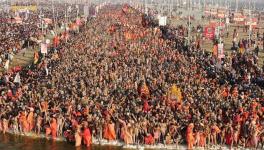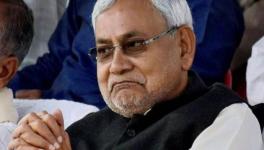Bihar Clashes ‘Attempt’ to Make Caste Census Politically Ineffective
File Photo.
New Delhi: The communal violence a day after Ram Navami and a series of mob lynchings in Bihar in the recent past show that the BJP has revived Hindutva politics to win over the politically significant Luv-Kush equation and cause a dent in the M-Y vote bank.
While chief minister (CM) Nitish Kumar-led JD(U) banks on Kurmis and Koiris, or Kushwahas (Luv-Kush equation), the deputy CM Tejashwi Yadav-headed RJD has its core voters among Muslims and Yadavs (M-Y) in Bihar.
The Kurmi and Koiri castes constitute 13% of the state’s total voters and Muslims and Yadavs comprise 17% and 16%, respectively.
Considered the BJP’s traditional supporters, the combined strength of Brahmins, Rajputs, Bhumihars and Kayasthas (the so-called upper castes) is not more than 17%.
Bihar is one of the states which will decide the BJP’s fate in the 2024 Lok Sabha election. The state’s political equations were not in the BJP’s favour after the seven-party Grand Alliance (JD-U, RJD, Congress and Left parties) beat Hindutva politics with several policies, especially the caste census.
Sensing the danger, the BJP has begun using the tried and tested ploy of polarising Hindu voters. A spate of lynchings and communal tension in several districts were seemingly parts of the strategy to divide voters communally.
If locals and those observing the state’s politics for decades are to be believed, Kurmis, Koeris, Yadavs and Dalits were incited to participate in the riots.
According to political observer and economist Vidyarthi Vikas, the riots in Bihar Sharif and Sasaram were “one-sided attacks” on Muslims.
“Bihar emerged with a resilient secular fabric after independence. It witnessed such large-scale communal violence after a long time, giving the BJP an excuse to revive its Hindutva politics in the caste-ridden society,” he told Newsclick.
The Hindutva ideology, according to him, has deeply penetrated society. “Religious gatherings in the state are highly sponsored. Both JD(U) and the RJD have failed to keep their Hindu voters religion-neutral to counter the Hindutva narrative,” he said. “It is high time that both Nitish and Tejashwi should work on their cadres and consolidate their core voters.”
With the general election only more than a year away, there has been a spurt in such incidents, which polarise the state.
“The BJP has snatched lord Ram from Hindus,” CPI (ML) leader Kumar Perwez said. “It is a warning signal, and BJP’s rival parties must note it. We will have to rise above just one slogan.”
The violence in Nalanda (Kumar’s constituency) and Rohtas districts was “an utter failure of the police and the intelligence”, he said.
“It was pre-planned. Preparation was going on for a month, but the state intelligence had no information. The police let thousands of people gather in these districts. Permission was granted to Shobha Yatras without deploying an adequate police force. There was no back-up plan to deal with a law and order situation,” he added.
“Genocidal slogans targeting a particular community were allowed to be raised. Rioters were allowed to run amok for hours—the traditional voters of JD(U) and RJD,” he alleged.
If the Opposition has to defeat the BJP, it must work on the ground instead of indulging in “photo ops” and reconsolidate voters, Perwez said.
The riots, many believe, were a strong counter to the consolidation of OBC, EBC and Dalit voters in favour of the Grand Alliance due to the caste census.
Political commentator Anil Rai questioned what stopped the CM and his deputy from visiting the riot-hit areas, meeting the victims—most of whom are JD(U) or RJD office-bearers—instilling confidence in them that they would get justice and talking to their communities to stay away from decisive politics.
“Bihar’s voters trusted Nitish Kumar and brought him to power thrice consecutively. If he does not reach out to his voters, it’s a betrayal. Tejashwi should also hold meetings with his cadres and warn them of communal politics. Bihar had trusted Krishna Sinha too in 1946, but the state witnessed the worst communal violence during his rule,” he said.
Citing the unfurling of saffron flags as the handiwork of a few anti-social elements to disturb the peace, the police lodged several FIRs against four named and several unnamed accused and arrested VHP’s Darbhanga district secretary Rajeev Prakash Madhukar.
Traditionally, Bihar elections have been a triangular contest between JD(U), RJD and BJP. The JD(U)-BJP coalition won the 2005 and 2010 Assembly elections and was in power for two consecutive terms.
The allies since the 1990s parted way in 2015 with the JD(U) joining the RJD-led grand alliance comprising the Congress and Left parties. But the combination did not work with the JD(U) realigning with the BJP in 2017.
In 2020, the JD-U and BJP formed the NDA government with the RJD, despite being the largest party in the Assembly, sitting in the Opposition.
However, Kumar’s party was becoming increasingly wary of the BJP’s dominant position in the alliance with seeds of discontentment being sowed in 2019 when the JD(U) was offered just one Union Cabinet berth.
Though the JD(U) supported NDA candidates in vice-presidential and presidential elections, Kumar chose to skip many important functions and didn’t even attend NITI Aayog meet.
The JD(U)’s principal concerns were the alleged attempts of the BJP high command, including Union home minister Amit Shah, to divide the party. Tensions spiralled after the party accused its former leader RCP Singh of corruption and serving as Shah’s proxy. Singh quit the JD(U).
Finally, the JD(U) again walked out of alliance with the BJP and joined hands with the opposition RJD.
Get the latest reports & analysis with people's perspective on Protests, movements & deep analytical videos, discussions of the current affairs in your Telegram app. Subscribe to NewsClick's Telegram channel & get Real-Time updates on stories, as they get published on our website.
























